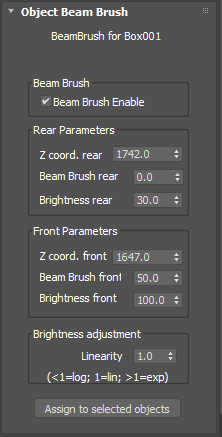Tools
Support
Pangolin Family of websites
Pangolin Laser Systems, Inc.
Kvant Lasers
Unity Lasers
ScannerMAX
Lasorb
Tools
Support
Pangolin Family of websites
Pangolin Laser Systems, Inc.
Kvant Lasers
Unity Lasers
ScannerMAX
Lasorb
This panel allows you to control the Beam Brush (dynamic divergence), and also separately Z-based brightness depth cueing of lines, on an object-by-object basis.

Beam Brush is dynamic beam divergence technology manufactured by the ScannerMAX division of Pangolin, and included in certain projectors manufactured by Kvant. The Beam Brush features of the Lasershow Converter MAX plug-in allow you to effectively map the Z-axis coordinate data from 3ds Max onto the beam diameter found in the 3ds Max objects. Each object can have its own Beam Brush settings, providing tremendous power and flexibility.
The aspects of the Beam Brush panel are described below.
Beam Brush Enable must be checked for any of the other settings on this panel to have affect on the rendered object.
Z coordinate of the rear is the 3ds Max Z coordinate that will be mapped onto the far-away dynamic divergence, and also will be applied to the brightness of the object.
Beam Brush rear is the dynamic divergence value that will be used and effectively “mapped onto” the Z coordinate rear specified immediately above.
Brightness rear is the brightness value that will be used and effectively “mapped onto” the Z coordinate rear specified immediately above.
Z coordinate of the front is the 3ds Max Z coordinate that will be mapped onto the near dynamic divergence, and also will be applied to the brightness of the object.
Beam Brush front is the dynamic divergence value that will be used and effectively “mapped onto” the Z coordinate front specified immediately above.
Brightness front is the brightness value that will be used and effectively “mapped onto” the Z coordinate front specified immediately above.
Linearity provides an additional level of control over the fading action. When this number is set to less than 1, a logarithmic ramp is used. When this number is greater than 1, an exponential ramp is used.
Note that a Beam Brush value of 0 represents nominal laser divergence (typically 1mRad or less), and a Beam Brush value of 100 represents the maximum divergence that the laser is capable of (typically around 30 milliradians).
Below you will see a simple wireframe cube, on which the Beam Brush feature is enabled. Both the Beam Brush as well as the Depth Cueing are clearly visible.
Also note that the Front Z and Rear Z information appears in the 3ds Max Viewport as well as the Virtual Frame Buffer, and even the Lasershow Converter MAX preview panel. These are entered into the Beam Brush Z-axis values, to “map” the Z-axis coordinates in 3ds Max onto Beam Brush and Brightness.